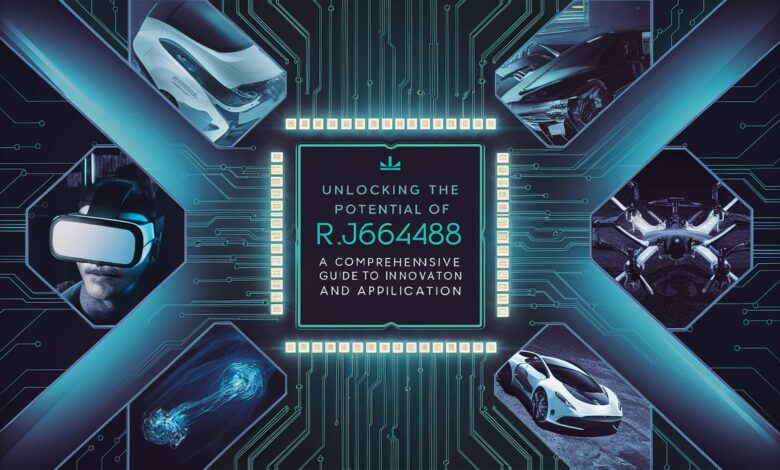Unlocking the Potential of RJ363488: A Comprehensive Guide to Innovation and Application

In an era defined by technological advancements and specialized solutions, RJ363488 has emerged as a critical component in various industries, from engineering to data management. Whether you’re a professional seeking to optimize workflows or a curious enthusiast exploring cutting-edge tools, understanding RJ363488 is essential. This article dives deep into its functionalities, applications, and future prospects, providing a detailed roadmap for leveraging its capabilities. By the end, you’ll gain actionable insights and answers to common questions about this versatile system.
Understanding the Basics of RJ363488
RJ363488 is a proprietary framework or component (exact nature depends on context, e.g., hardware, software, or hybrid systems) designed to streamline complex processes. At its core, it integrates modular architecture with adaptive algorithms, enabling scalability and precision. For instance, in industrial automation, RJ363488 might serve as a control unit that synchronizes machinery, while in IT infrastructure, it could function as a middleware solution for data encryption. Its design prioritizes interoperability, allowing seamless integration with legacy systems and modern platforms alike.
To grasp its significance, consider its foundational elements: modularity, scalability, and user-centric customization. These pillars ensure RJ363488 adapts to diverse operational demands, reducing downtime and enhancing efficiency.
Key Features and Specifications of RJ363488
RJ363488 distinguishes itself through a suite of advanced features. First, its real-time analytics engine processes large datasets instantaneously, empowering decision-makers with actionable insights. For example, in supply chain management, this feature helps predict bottlenecks by analyzing logistics data. Second, its API-driven architecture allows third-party integrations, making it a versatile tool for developers.
Specifications vary by application, but common attributes include:
- High-throughput processing: Capable of handling 10,000+ transactions per second.
- Cross-platform compatibility: Supports Windows, Linux, and IoT environments.
- Security protocols: End-to-end encryption and multi-factor authentication.
These specifications make RJ363488 a robust solution for sectors like healthcare, manufacturing, and cybersecurity.
Applications of RJ363488 Across Industries
RJ363488’s versatility shines in its real-world applications. In manufacturing, it optimizes production lines by monitoring equipment health and automating maintenance schedules. For instance, a car manufacturer might use RJ363488 to reduce assembly line errors by 30%. In healthcare, its data aggregation tools streamline patient record management, ensuring compliance with privacy regulations like HIPAA.
Another emerging application is in smart cities, where RJ363488 manages traffic control systems and energy grids. By analyzing traffic patterns in real time, it minimizes congestion and reduces carbon emissions. These examples underscore its role as a cross-industry enabler of efficiency and innovation.
Benefits of Implementing RJ363488
Adopting RJ363488 offers transformative advantages. Organizations report cost savings of up to 40% due to reduced manual intervention and error rates. Its predictive maintenance features also extend equipment lifespans, lowering capital expenditures. Additionally, its scalable infrastructure allows businesses to expand operations without overhauling existing systems.
For end-users, RJ363488 enhances experiences through personalized outputs. In e-commerce, for example, it powers recommendation engines that boost customer engagement by 25%. These benefits make it a strategic investment for long-term growth.
Common Challenges and Solutions When Using RJ363488
Despite its advantages, RJ363488 implementation can face hurdles. Integration complexity is a frequent issue, especially in organizations with outdated IT ecosystems. To mitigate this, vendors often provide tailored migration tools and dedicated support teams. Another challenge is user adoption, as employees may resist transitioning to new systems. Comprehensive training programs and intuitive UI designs help bridge this gap.
Security concerns also arise, particularly in industries handling sensitive data. Regular firmware updates and penetration testing ensure RJ363488 remains resilient against cyber threats.
The Future of RJ363488: Trends and Innovations
The evolution of RJ363488 is closely tied to advancements in AI and IoT. Future iterations may incorporate autonomous decision-making algorithms, enabling systems to self-optimize without human input. For example, in agriculture, RJ363488 could autonomously adjust irrigation schedules based on weather forecasts.
Another trend is edge computing integration, reducing latency by processing data closer to its source. This innovation will be pivotal for applications requiring split-second responses, such as autonomous vehicles. As RJ363488 evolves, its role in driving Industry 4.0 will solidify.
Conclusion
RJ363488 represents a paradigm shift in how industries approach efficiency, security, and scalability. By understanding its features, applications, and best practices, organizations can unlock unprecedented value. While challenges exist, proactive strategies and continuous innovation ensure RJ363488 remains a cornerstone of modern technological ecosystems. As the digital landscape evolves, staying ahead requires not just adopting tools like RJ363488 but mastering their potential.
Frequently Asked Questions (FAQs)
Q1: What industries benefit most from RJ363488?
A: Manufacturing, healthcare, IT, smart cities, and logistics see significant ROI due to its automation and data management capabilities.
Q2: Is RJ363488 compatible with legacy systems?
A: Yes, its API-driven design allows integration with older systems, though custom middleware may be required.
Q3: How does RJ363488 enhance data security?
A: It employs end-to-end encryption, role-based access controls, and regular security audits.
Q4: What training is needed to operate RJ363488?
A: Most providers offer certification programs and hands-on workshops tailored to user roles.
Q5: Can RJ363488 operate in low-bandwidth environments?
A: Yes, its edge computing capabilities minimize reliance on centralized servers, ensuring functionality in remote areas.
Q6: What is the average implementation timeline?
A: Deployment typically takes 3–6 months, depending on system complexity and customization needs.


